| Please access the following URL if you want to secure using SSL. All pages in the site will be secure pages. |
| https://secure02.blue.shared-server.net/www.fish-food.co.jp/message english 12.2019.html |
Welcome to FISH FOOD TIMES
Dec. 2019 issue No.192

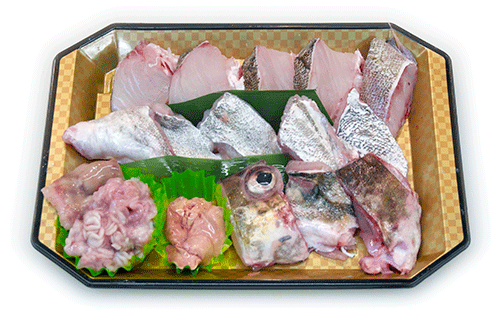
Pacific cod hot pot fillet
Prelude
This month is a major class of fish. Too well-known fish seems to be said to be "everyone knows that ...", and it is difficult to write an article. In particular, the writer who lives in Kyushu-Fukuoka often wonders if something is wrong when dealing with fish living in the north sea because they are not familiar with them. I'm not very confident in expressing. But if I'm afraid of it, I can't write anything anymore, so I'd like to write it down. However, if you find any misunderstandings, please contact me.
Actually, “Welcome to FISH FOOD TIMES” at the beginning of this homepage has been “... to TIIMES” for a long time. The author never noticed that and left it for three years and three months. And the reader on November 23 (Saturday) just pointed out the careless mistake by e-mail, and the author, the site administrator, hurriedly went back 39 months and corrected it one by one. And just updated each page.
I realized that “believing that I am right”, which I couldn't realize by myself, was only noticed by someone else's eyes, and that was the importance of “proofreading” in the text. Unfortunately, I am not only managing the site, but also doing all the articles, images, and updates by myself, so this “proofreading” part is a major weakness.
This has been the case before. At the time of Emperor red snapper sashimi (Jul. 2017 issue No.163), an email was sent from a reader. The email was marked with "I emailed it because I thought it was a doubt in the July issue. Isn't this fish a Malabar blood snapper, not an Emperor red snapper? I have seen the Emperor red snapper, but the old fish still have thin horizontal stripes. ”
The author was delivered from the fish market under the name of Emperor red snapper, so I thought so without any doubt, but if I looked closely after receiving the email, it was certainly Malabar blood snapper instead of Emperor red snapper I thought it might be. However, it may have been a problem that the author did not doubt the words of the fish market staff, but basically, as a position to retail fish, I thought it was not good that change the name of the fish on the slip arbitrarily.
Even if it is wrong, it is difficult to rewrite the full text of the July issue without losing the meaning of the previous and subsequent sentences. For this reason, I thought of a remedy that supplemented the text on my own. All of these fish are not clearly distinguished in Okinawa and the Nansei Islands, and are all called by local names such as "Sambana (Sambara Dai)". I decided to add an article saying that I wanted to do that.
The author has continued FISH FOOD TIIMES for 16 years, but some of them are sometimes educated and studied by a number of enthusiastic readers. Perhaps this month's issue may be pointed out that there is a mistake, but I am willing to accept it and I want to finish the long introduction.
Eat plenty
Madara is a Chinese character with a snow character. As this is written in Honcyosyotukan's book, “This is because pacific cod is caught after the first snow,” pacific cod begins in December, the cold season when snow falls.

It is not uncommon for pacific cod to arrive in this way. It is a pacific cod that was caught while eating in a full stomach.

When you open the large swollen abdomen, you can see a large stomach, liver, testes (shirako, kikuwata, kumoko). Especially when you open the large stomach, there are many kinds of fish that are preyed by pacific cod, such as squid and small fish.
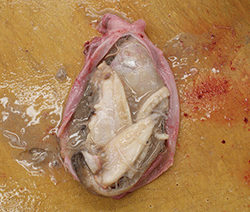
When you purchase pacific cod, the price counts even the weight of unusable fish in the stomach. So, the larger the abdomen, the higher the yield cost. As a result, it is better to sell fixed-quantity than un-fixed-quantity when selling products.
Although the contents of the stomach can not be sold, the stomach itself can be used as a hot pot food. The stomach bag is halved, and the mucous membrane and dirt stuck to the surface are scraped off by scraping the back and front of the stomach bag with the knife tip. This is then mixed with salt and washed with water, then boiled, cut and attached to the cut product.

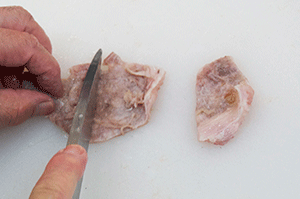
Liver and testis are also important ingredients like pacific cod fish meat. The lower left is the liver and stomach, and the lower right is the testis.
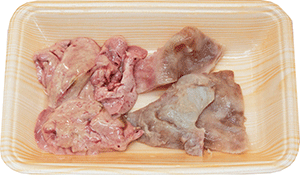
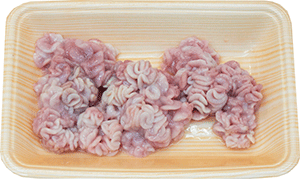
In addition, pacific cod with a large fish is basically used for hot pots, such as the head that is often discarded as leftover fish scraps. For example, Aomori Jappa soup and Yamagata dongara soup are fishermen's dishes that use leftover fish scraps of fish called “Jaste” or “Dongara” which means “waste material” in each region. It is a way to taste pacific cod's leftover fish scraps without sacrificing them and making them delicious.
The method of cutting the head of pacific cod into a good shape as a hot pot fillet is as follows.
| Work process of pacific cod head fillet | |
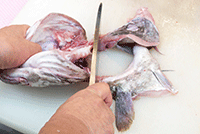 |
 |
| 1,Cut off the collar of a fish on the head | 4,Cut the head in half |
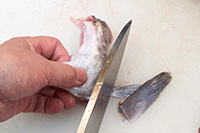 |
 |
| 2,Cut off the fin of a collar of a fish | 5,Separate and remove gills lid etc |
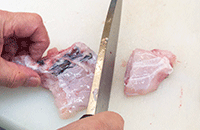 |
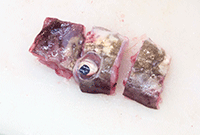 |
| 3,cut and divide a collar of a fish | 6,Cut the head into equal parts |
Commercialization of pacific cod for hot pod
When commercializing the fillets of pacific cod, the processing methods for leftover fish scraps and internal organs that are important in terms of increasing added value are described above. The next method is to slice the fish body for hot pot. Only the half body with centralbone was made into a hot pot fillet, the half body without centralbone was made into boiled fish or a slice for frying, and the following work was done.
| Work process of slices for pacific cod hot pot | |
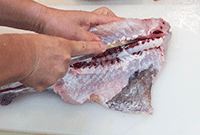 |
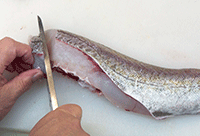 |
| 1,A pacific cod with a large belly bone cuts a belly bone by cutting a knife from the abdomen. | 6,Cut the knife from the skin with the backbone down, and cut it into a size of around 50g |
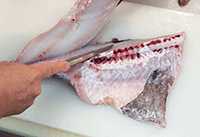 |
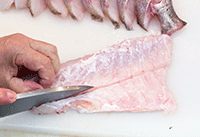 |
| 2,Cut the abdominal bone and separate the lower body by one side dismantling work. | 7,Cut the abdomen further into two parts |
 |
 |
| 3,Two pieces disassembling finished | 8,Cut as much as possible into a wide range |
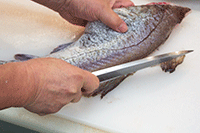 |
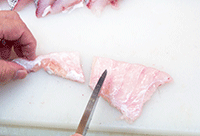 |
| 4,Cut off all fins of the half body with bone | 9,Cut the end of the abdomen as wide as possible because it is thin |
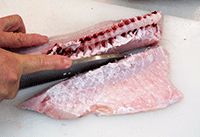 |
 |
| 5,Cut the body of the half body with bones into two from the abdomen | 10、A state where the half body with bone is cut into the same size |
The following image shows a state where preparations for commercializing the body, head, internal organs, etc. of the half body with bones of the pacific cod for hot pot use have been completed.
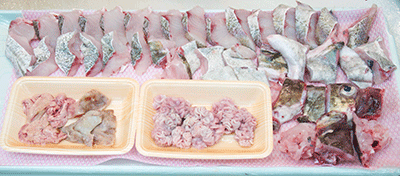
Commercialization using these will be as follows.
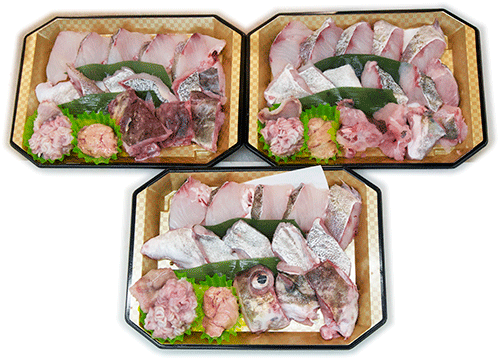
The hot pot material on Pyres made this 3-pack product, but I would like to sell it for 1,980 yen. As of late November, the pacific cod market price in Kushiro and Hanasaki in Hokkaido is around 600 yen / kg with a high price of 3 fishs and about 200 yen / kg with a bottom price of 8. The value of the product depends on how much pacific cod is purchased, and the yield rate of the small one is also bad, considering the size of the leftover fish scraps and internal organs, the fish body If it is small, it should be prepared that only that value can be realized.
Since this pacific cod still has two halves without centralbone, they were cut as shown in the image below.
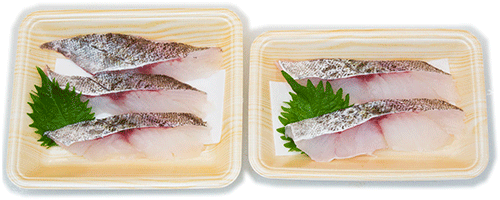
Slices using half body without centralbone are difficult to add value. That's because slices like this are competing with frozen imported products such as Alaska pacific cod, so the selling price is inevitably limited.
Global demand for pacific cod
The market price of frozen Alaska pacific cod, which is its competitor, seems to be over 10% cheaper than last year. The price of pacific cod, which has maintained a strong popularity all over the world, was about 50% higher in 2018 than in 2016, but the reaction to this soaring price caused a decline in demand. It seems that it has entered the price adjustment phase.
As of November this year, the price of the US pacific cod price is about 550 yen / kg for frozen headless with the head and internal organs removed, but the handling of frozen pacific cod is It's not that easy.
This is because the moisture content of pacific cod is very high. If the frozen pacific cod is not thawed well, a lot of drip will come out, not only will the cost increase due to the deterioration of the thawing yield, but also the umami component will come out at the same time. This may spoil the taste of pacific cod.
The following materials were researched and published by Fumiko Ueyanagi at Shizuoka Women's University. This figure shows that the water content of pacific cod is exceptionally high among fish typical for food use, while the fat content is very low and the muscle fibers are very few.

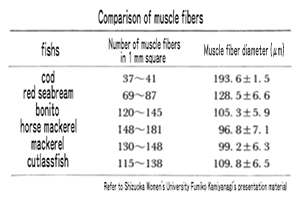
In other words, pacific cod can be described as a fish that is very watery, soft and has a light taste. If you make a mistake in handling fish with these characteristics, It may be stamped as a fish that is not very tasty. However, the fact that pacific cod is widely eaten around the world may mean that there is a good way to handle it deliciously.
After all, the point is how to handle the high water content, which is one of the major features of pacific cod. For this reason, it seems that one is to salt and the other is to dry.
First, regarding salt, there is a product called sweet-salt cod that is lightly salted to remove some moisture. This product not only condenses umami components by reducing moisture, but also has the effect of increasing the elasticity by coagulating proteins with the power of salt. If frozen pacific cod does not remain frozen, but gives a fresh feeling of elasticity, sweet salt is better than frozen, but there is a demerit that the expiration date cannot be so long.
On the other hand, there has been a drying method called dried cod that has been used for a long time. This dried cod has been proud of its presence as a preserved food since ancient times, and most cod dishes around the world seem to be basically made from dried cod. For example, Portuguese Bavariau, French branded, Pacarao al Pilpil in Spanish Basque Country, Italian Baccarat, British Fish and Chips, Korean Soup Food Goo, Norwegian Rute Fisk cod is the premise of cooking.
Japanese dried cod dishes
This is a dried cod in Japan as well, which is the stick cod in the image below.
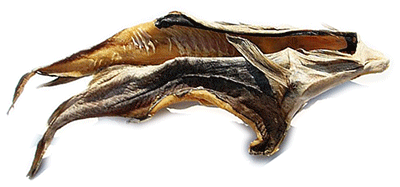
The stick cod is to be exposed to the cold winds of the cold northern country for about two months and hung outdoors to dry until it becomes ticking.

Stick cod, which has reduced moisture to the limit, is a preserved food that can be stored for a long time in Hokkaido, Tohoku, etc., and it seems that it has been used for various dishes in northern countries such as boiled stick cod. Not only that, it was transported to Kansai by Kitamaebune and has produced a special dish of Kyoto called “Imobou”, which is cooked with stick cod along with a kind of “ebiimo” of satoimo.
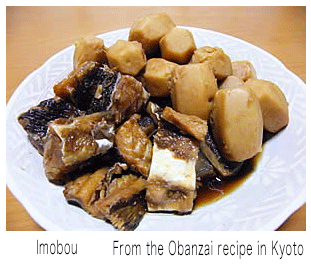
And the dried cod has not been eaten in Kansai, but has long been eaten in Kyushu, a southern country.
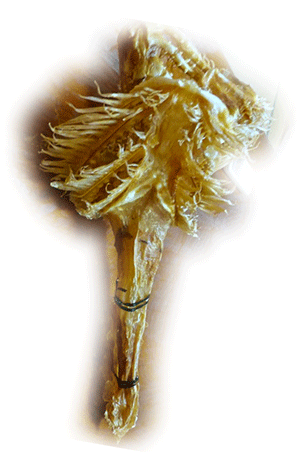
The image above is not a brush. This is a dried pacific cod called "Taraosa" in Hakata and Hita. This is different from the meat part such as stick cod, and it is a dry product of the internal organs and stomach. People from these areas have always been called “Bondara” because they always ate at the Obon festival.
Even so, there may be people who prefer not to eat this kind of thing, but in fact, since I was born in Fukuoka, when I was a child I went to a relative's house at the Obon festival, I always ate boiled fish of Taraosa. To tell the truth, there is no impression that I ate so much, and I remember that my child was wondering why such a strange food is good.
Why did Hakata and Hita prefer to eat fish internal organs like Taraosa? In the old days, stick cod and taraosa were delivered from Matsumae to various places on the Kitamae ship. The ship also goes through the port of Maizuru in Kyoto, so the stick cod of the fish meats part is almost sold in Kyoto, and taraosa, which is cheaper than the remaining stick cod, reaches Hakata, and the Hakata merchants make the boiled fish It is said that they ate. This is because merchants don't spend much money on food, and it is speculated that they preferred Taraosa, which was cheaper than stick cod at the time. In addition, Hita was a territory in the Edo period, and it was a strategic place where goods gathered from various places, so it is thought that Hakata merchants also told about Taraosa when they went to Hita for business. And in Amagi and the surrounding Chikugo area on the way from Hakata to Hita, these can now be eaten in the same way.
The author feels nostalgic that I want to eat it after a long time when I think that it is now that I no longer eat Bondara at the Obon festival every year. I haven't made it myself, but according to the materials, it takes 3 days to make a boiled fish of taraosa by immersing it in water and changing the water many times. After the water has penetrated into the internal organs and swelled with water, you can start cooking for cooking.
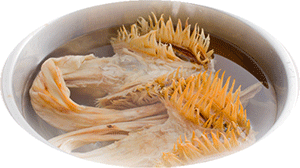
And the finished image is as follows.
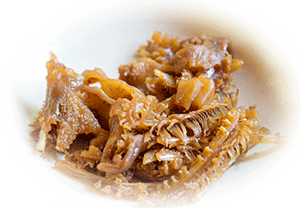
Taraosa boiled fish seems to boil not only the internal organs of pacific cod but also dried bamboo shoots. This is different from the soft texture of pacific cod meat, gills are jiggly, the hard part of gills is crunchy, the stomach is chewy, etc. You can enjoy different tastes depending on each part.
Valuable internal organs
y the way, I want to finish this month issue soon. Looking back at this article, although not intentionally intended, the content of the article began to begin with the internal organs and ended with the internal organs.
In addition to pacific cod, the common point when eating fish that prey on greedy, such as an anglerfish, is that it can be eaten almost without being thrown away except the bone and the thing which was digested in the stomach. Both are similar in that they can be eaten deliciously using the internal organs, especially including the stomach, liver, and spawn and testis.
When commercializing an anglerfish, it is difficult to produce value if you only have fish with no internal organs such as stomach and liver, skin and fins, and only fish. In the same way, it can be understood that it is difficult for pacific cod to be differentiated from frozen pacific cod only by half body without a central bone. The slices for the hot pot of the pacific cod in the intro image are not only the fish meat part, but also the head and internal organs etc. are attached to appeal the added value, and if they do not exist, it will be a very unattractive product It should be.
In addition to Japan, dried cods exist in order to use pacific cod, which has a strong decline in freshness due to its high moisture content, in many countries around the world. Although there is a fact that it is used as a dish, there seems to be no ultimate dish in the foreign country that does not waste any fish like Taraosa.
In the first place, the surprise is that the internal organs of fish caught in Hokkaido in the north are deliciously cooked and eaten in the south of Kyushu. I feel the wisdom of the ancestors who tried to utilize them without wasting any caught fish.
Will the current consumer use wisdom not to waste the internal organs of fish as much as possible? How many consumers understand the fact that when they eat sashimi, they use only 30% to 40% of a fish and then throw it away as garbage.
Recently, there has been a popular phrase such as “effective use of limited resources”. But once the old people know how to use pacific cod without waste, we feel that it is more important to learn the wisdom and follow the way of thinking. Even one fish can make me think.
An opinion and the communication are to iinfo@fish food times
Date of updating 1 Dec. 2019
